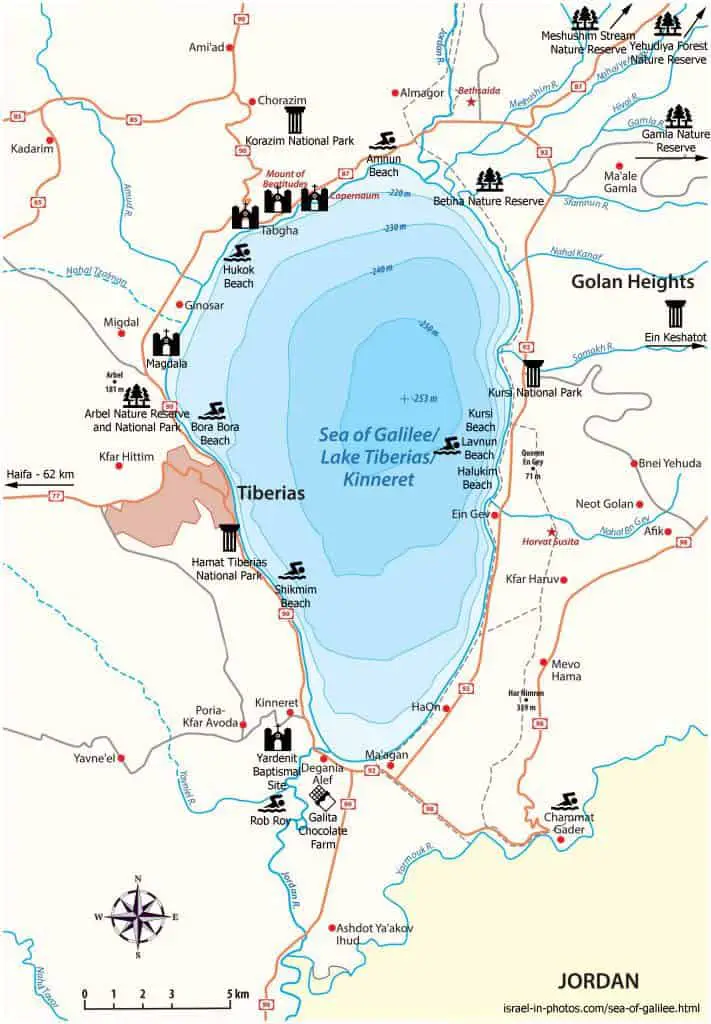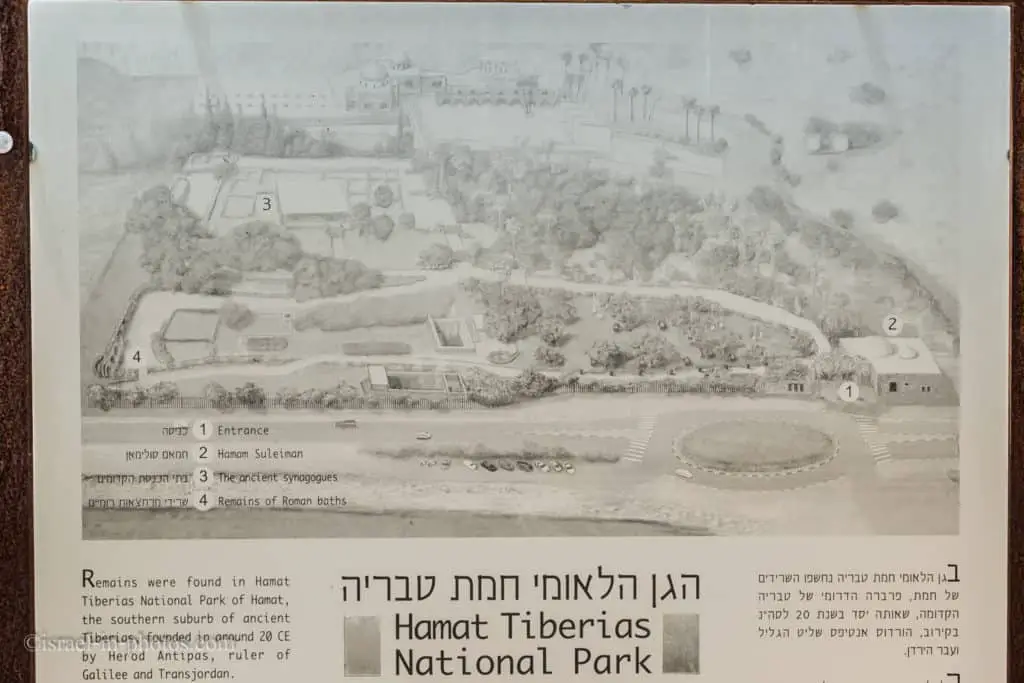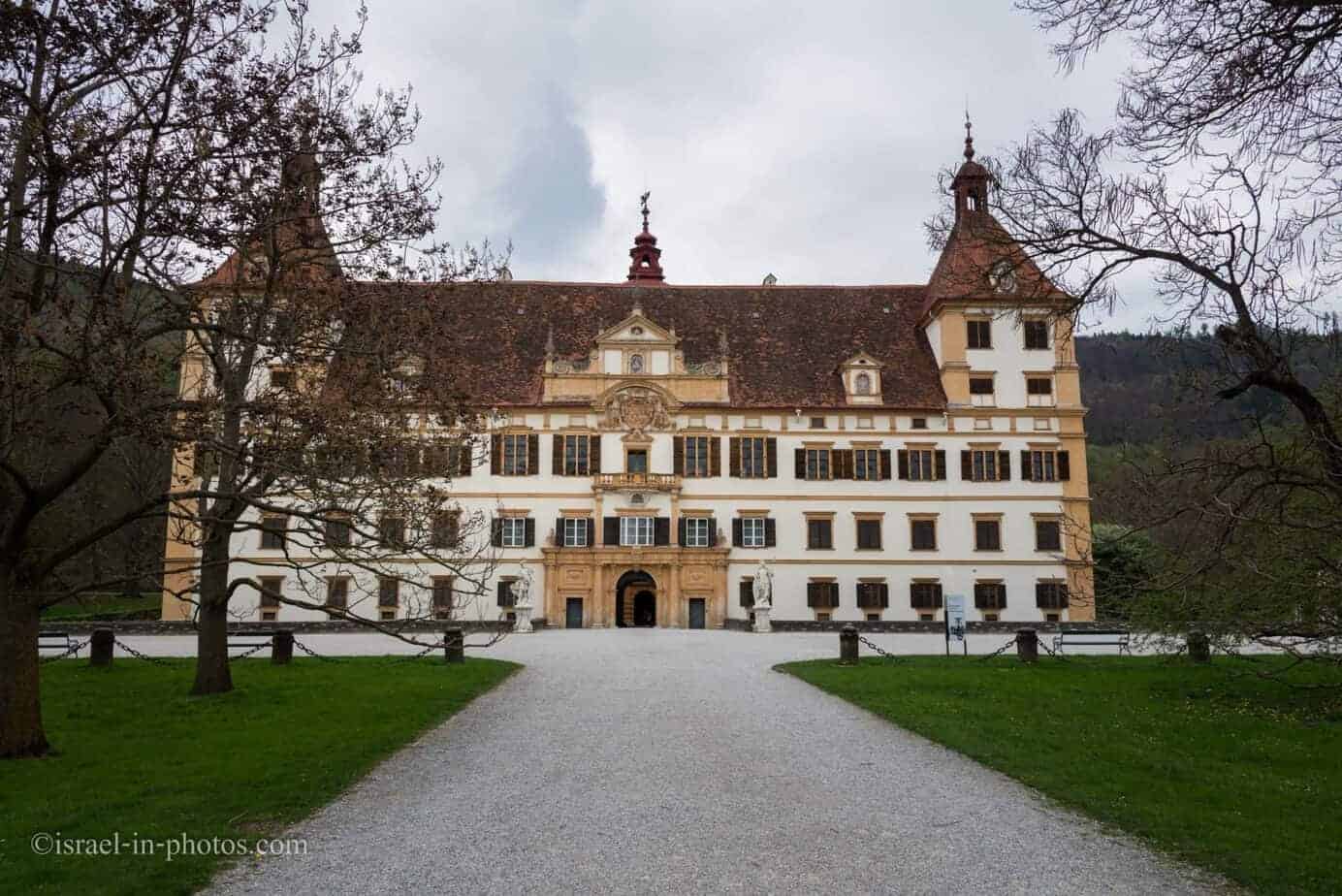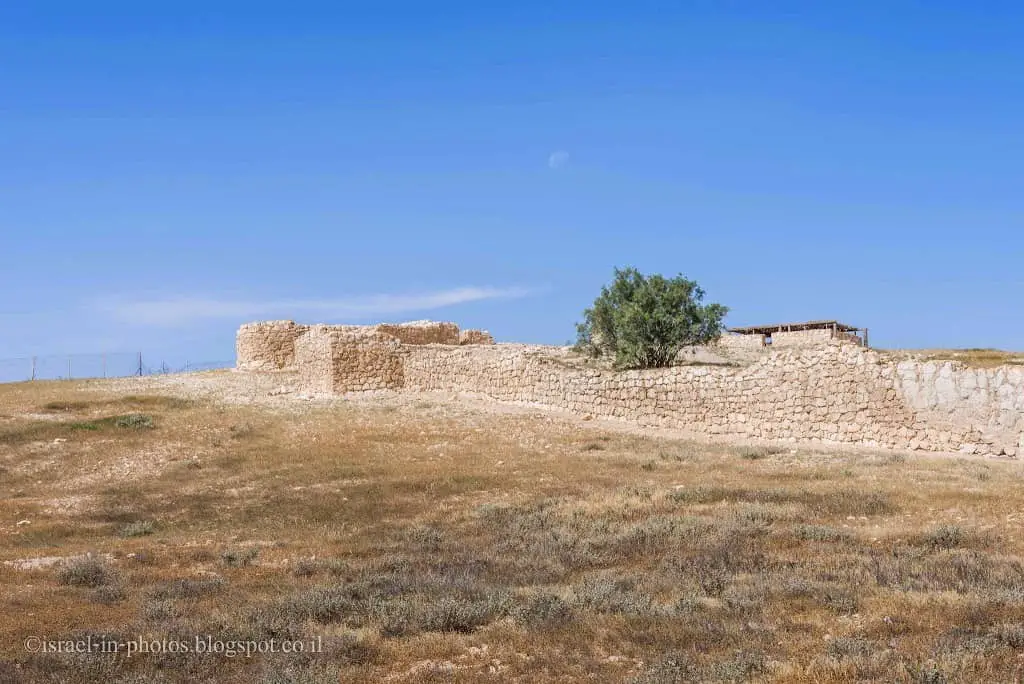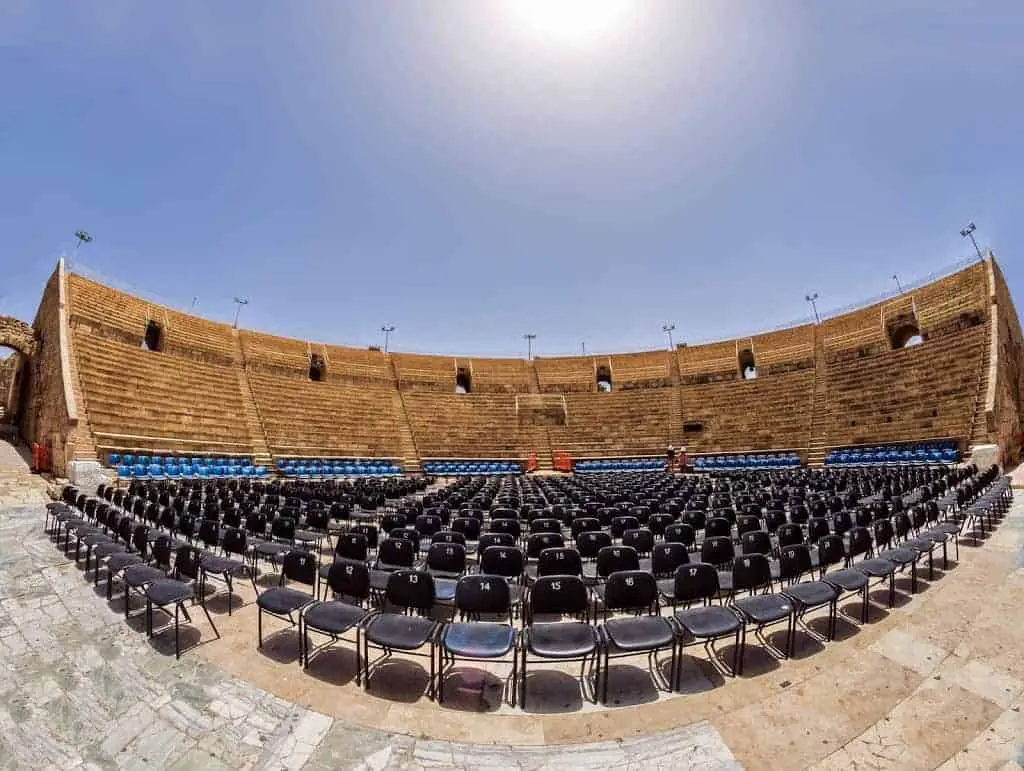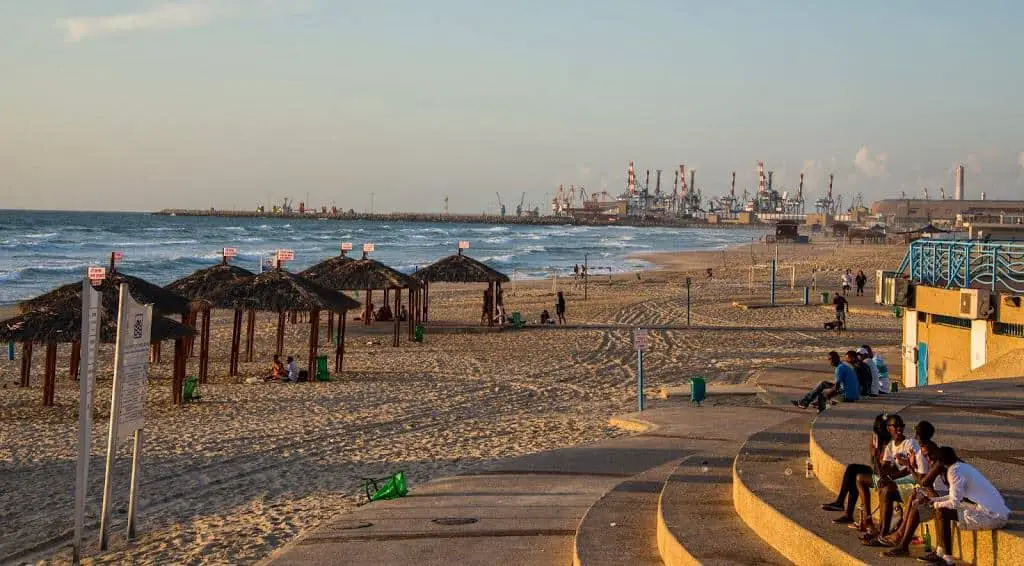Hamat Tiberias National Park – Ancient Hot Springs Site
At Hamat Tiberias National Park, you can enjoy hot springs and archeological remains (with a stunning zodiac mosaic in the Synagogue).
Table of Contents
Map
Hamat Tiberias National Park is located on the western shore of the Sea of Galilee near Tiberias. On the following map, you can see this national park on the left coast below Tiberias.
Directions for drivers: Link to Waze and Link to Google Maps
Directions for public transport: Link to Moovit
Interactive map of the area:
And here is a photo of the map:
Hamat Tiberias National Park is one of the smallest parks. And though there is no scale, walking from one end to another will take less than five minutes.
Number 1 marks the entrance, and nearby you can find Hamam Suleiman (#2). And on the far end, you can find the ancient Synagogue (#3) and remains of Roman baths (#4).
Directions
If you are reaching by car, enter “Hamat Tiberias National Park” into Waze or Google Maps, and it will take you there. Furthermore, you will find free parking near the entrance.
And if you are using public transport, you can take bus #5, #15, #28 or another to a nearby station. Here is the updated link to Moovit. Enter your starting point, and you will get the updated directions.
Moreover, if you stay in Tiberias, not far from the Sea of Galilee, check the option of walking there.
Opening Hours
Sunday – Thursday and Saturday: 8:00 – 17:00 (16:00 in winter).
Friday: 8:00 – 16:00 (15:00 in winter).
On holiday eves, usually 8:00 – 13:00.
Note: Since the pandemic, the Israel Nature and Parks Authority has started limiting the number of people in each park. Thus, reservations are recommended through the official site (you can find the link below).
Entrance to the site closes one hour before the time mentioned above.
Entrance Fee
Adult 14 NIS, child 7 NIS, and student 12 NIS. Free for National Parks annual subscribers.
If you visit several National Parks, then consider purchasing a combo ticket. You can find additional info at National Parks And Nature Reserves.
Note: opening hours and ticket prices were updated on January 2023. In any case, recheck the official site before visiting.
Contact Information
Phone: 04-6725287
When to Visit?
Hamat Tiberias National Park is located near the city of Tiberias (which was named in honor of the Roman Empire’s second emperor, Tiberius). Thus the weather there is the same as in Tiberias. That means boiling during the summer. So spring, autumn, or even winter are advised. Moreover, try to visit either during the morning hours or late afternoon (this is especially important during hotter days).
Tours
The Israeli National Parks Authority occasionally offers complimentary tours at Hamat Tiberias (included in the entry fee). These tours usually take place on Saturdays. You can check availability on the official website.
History
Remains were found in Hamat Tiberias National Park of Hamat, the southern suburb of ancient Tiberias, founded in around 20 CE by Herod Antipas, ruler of Galilee and Transjordan.
The city’s economic life was based on fishing, its fertile agricultural hinterland, and the therapeutic springs at Hamat Tiberias. Remains in the national park attest to the therapeutic springs at Hamat from ancient times to the present. These remains include a bathhouse from the Roman period and Hamam Suleiman from the Ottoman period.
In the 3rd century CE, the Sanhedrin, headed by the Patriarch, moved to Tiberias and became the world center for Jewish religious practice and law. The mosaic that adorns the ancient synagogue in the center of the park attests to the golden age of the city and its suburb, Hamat Tiberias. The Jewish community continued in existence in Hamat Tiberias until the mid-8th century CE.
Source: sign
In the Bible
Hammat Tverya is the elder sister of Tiberias, one of the fortified cities mentioned in the Bible within the land of the Tribe of Naftali: “And the fortified cities were Ziddim-zer, and Hammath, and Rakkath, and Chinnereth” (Joshua 19:35). In the Byzantine period, Hammat was surrounded by its wall. Parts of the southern wall of Hammat can be seen south of the hot spring in the National Park and south of the medicinal baths. Part of the northern wall can be seen north of the Rimonim Mineral Tverya Hotel (formerly – Ganney Hammat). From their remains, the walls of Hammat Tverya appear to have surrounded an area of approximately 180 dunams.
Note: unless stated otherwise, all quotes were taken from the official site.
Name Change
Only after the establishment of Tiberias (First Century CE) was the place called Hammat Tverya, to differentiate it from other places named “Hammat”. According to the Talmud, Hammat (also called Hamtan) was separated from Tiberias by only one mile (Megilla 4, 72). The area between the cities remained unbuilt because it served as a cemetery.
Healing Water
Healing properties were attributed to the waters of Hammat Tverya already in ancient times, and therefore the Halachic scholars permitted bathing in them even on Shabbat. In the Roman period, luxurious baths were built there, attracting people who sought healing from all over the empire. A coin struck in Tiberias in the time of Emperor Trajan (approximately 100 CE) displays the goddess of health, Hygeia, sitting on a rock from which a spring is flowing.
Archeological Excavations
In 1921 Nahum Slouschz began archaeological digs at Hammat. The very fact of the digs was a historical event since they were the first conducted in Israel by a Jewish archaeologist. The workmen were members of the Gdud Ha’Ivri, who discovered the site while laying the Tiberias-Tsemah road (presently the location of the Tiberias Hot Springs). During the explorations, a small synagogue was found that had been constructed in the 4th century CE. Among the findings were a seven-branched candelabra carved in chalk, a piece of a lattice on which there was a relief of a candelabra and a stone chair of the type called “Cathedra deMoshe”. The remains of this synagogue are no longer visible.
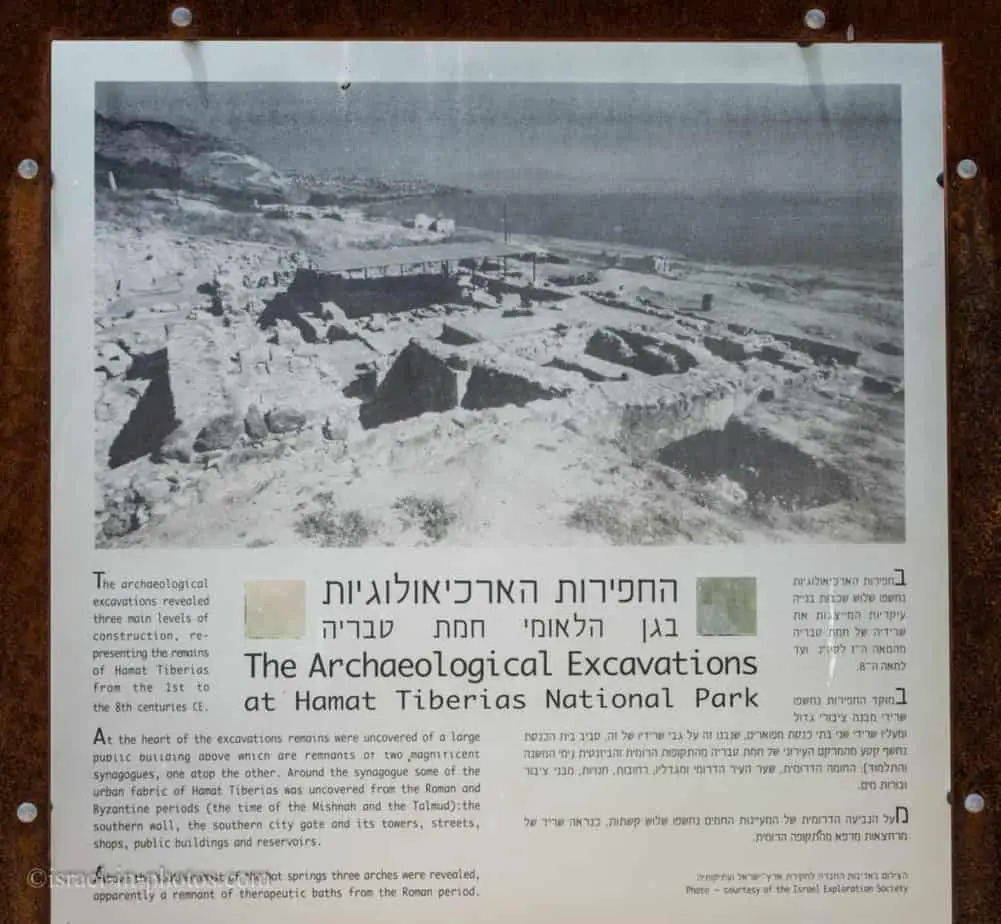
Meaning of the Name
Hammath or Hamma is the Hebrew and Semitic word for “hot spring.” The Hebrew possessive plural is hamei. It is adjacent to the ancient city of Tiberias, which was established in the first century CE and is now called “Tveriya”. Thus the springs and the resort are called Hamei Tveriya. Since several places bore the name “Hammath”, the distinction was made here by adding Tiberias to the name.
Source: Wikipedia
Similarly, Hamat Gader is another hot springs site.
Hot Springs
The first thing we saw when we entered Hamat Tiberias National Park was a small pool (pool depth is up to 40 cm). And along the path, you will find several other ones. Each next pool has a slightly higher temperature. This one, for example, is about 35 C.
Since this is not regular water, several disclaimers exist on site. One of them is that parents take full responsibility for small kids (up to six years old). And they also say that you can stay in the water for up to ten minutes.

The Hot Spring pools are small and not intended for many people. Thus if the purpose of your visit is staying in the Hot Springs, I would suggest visiting when few people visit this park or visiting another place. Like Hamat Gader.
The Hot Springs – within the national park, 17 thermo-mineral springs flow at a temperature of about 600C, with a saline concentration of 36.5 gram per liter, the majority in the form of chlorides of sodium and calcium and some potassium, bromide, and sulfate. The water flows in a system of underground channels to the Tiberias Hot Baths. The channels are built with chimneys to release steam pressure, and visitors to the park can see the steam pouring out of them. Surplus water that does not flow into the Tiberias hot baths is collected in a pool located on-site.
The surplus water and the water returning from the baths after use are collected in a Mekorot facility located within site and are conveyed to the National Saline Water Carrier.
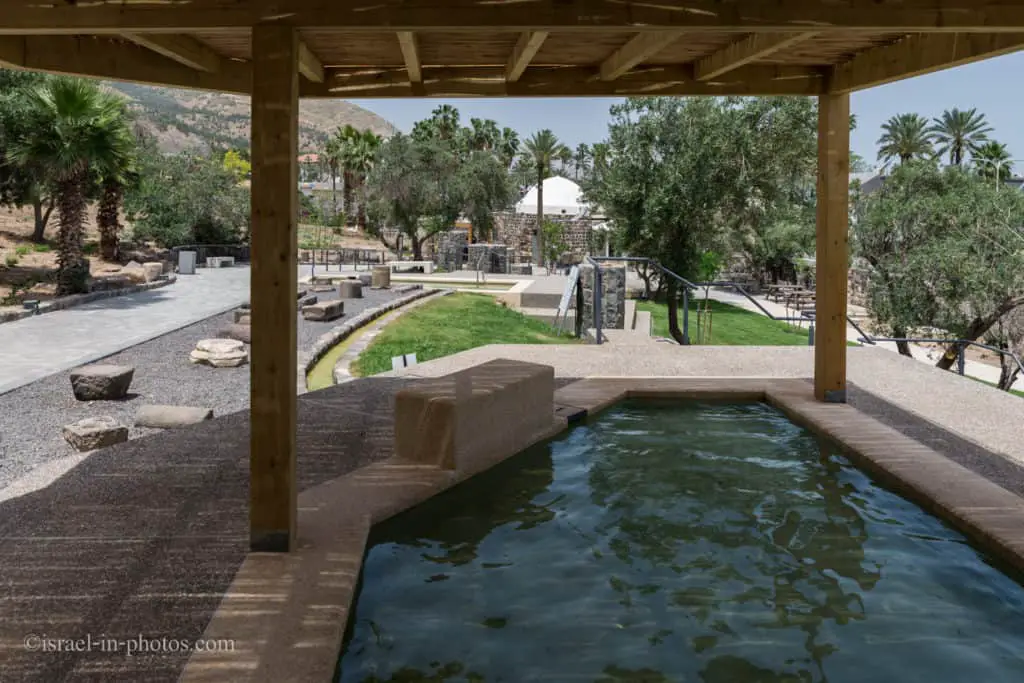
Hamam Suleiman
Since we mentioned hot springs, I should also mention Hamam Suleiman. You can see it in the background of the photo above, and it is also the ticket office.
Hamam Suleiman – in the early Muslim period (8th century), there was no real settlement at Hammat Tverya, but the baths continued to operate. Muslim geographers mention the baths in their writings. The Suleiman Hamam was built in 1780, in the period of Jezzar Pasha, ruler of the Damascus district. The Hamam served the inhabitants of the region and the pilgrims who came to be healed in its waters up to 1944.
The building of the Hamam has been reconstructed, and a visit there is a unique experience (the hall is air-conditioned). The building serves as a museum documenting the customs of the bathers in the Hamam.
And our next stop is the ancient Synagogue.
Ancient Synagogue
Severus’ Synagogue – the synagogue is located within the precincts of the ancient town of Hammat Tverya, close to the southern wall and the gate of the city.
The Synagogue and its beautiful mosaics are located within this air-conditioned glass building.
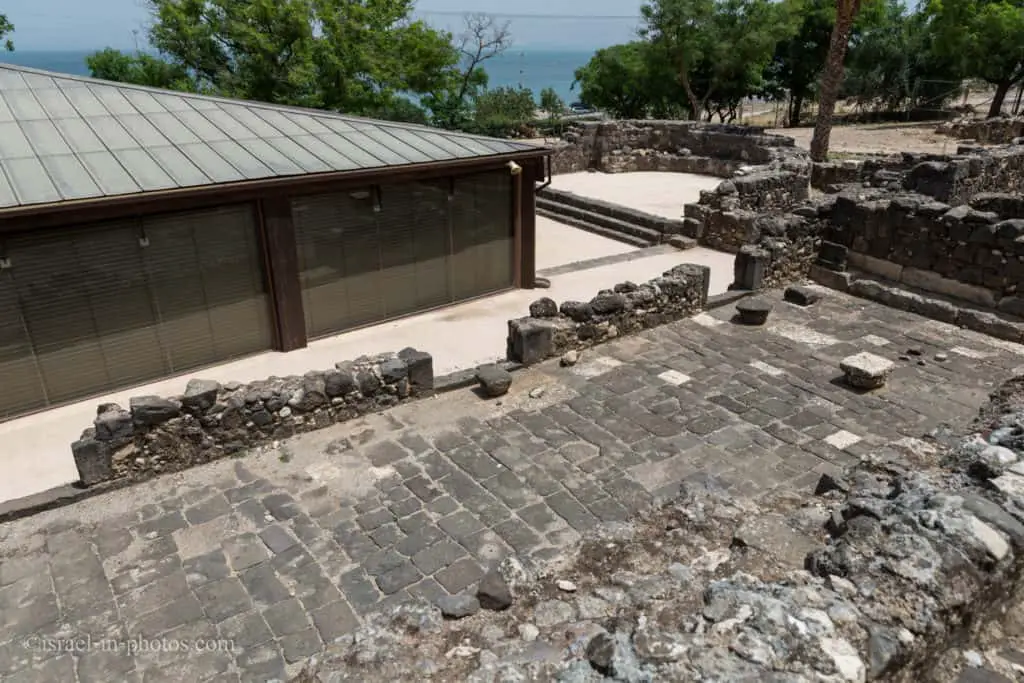
Near the southern wall:
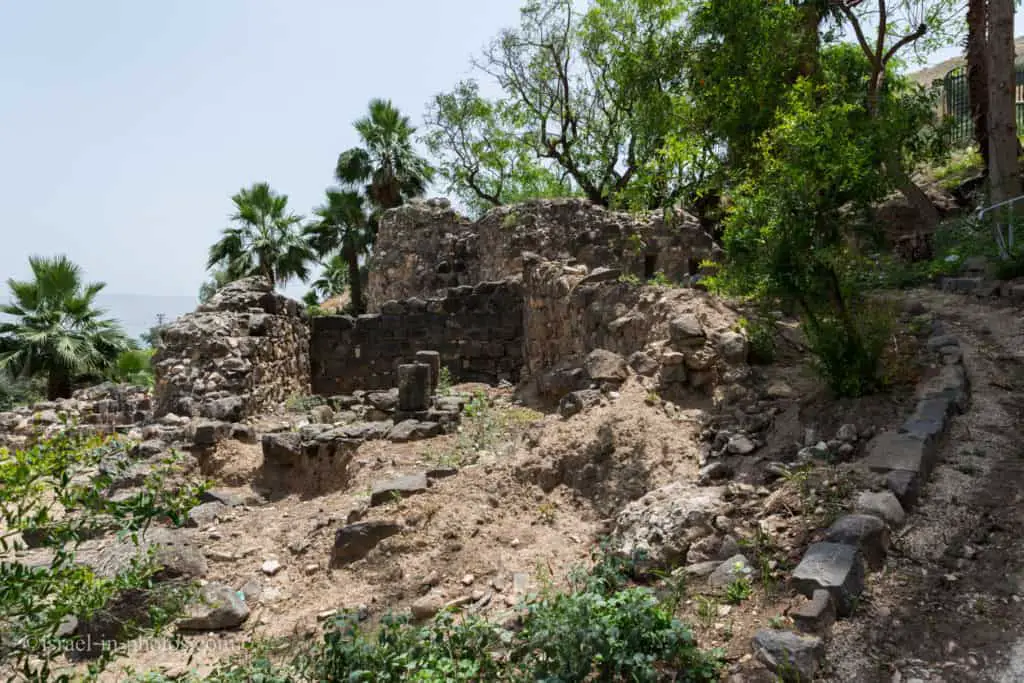
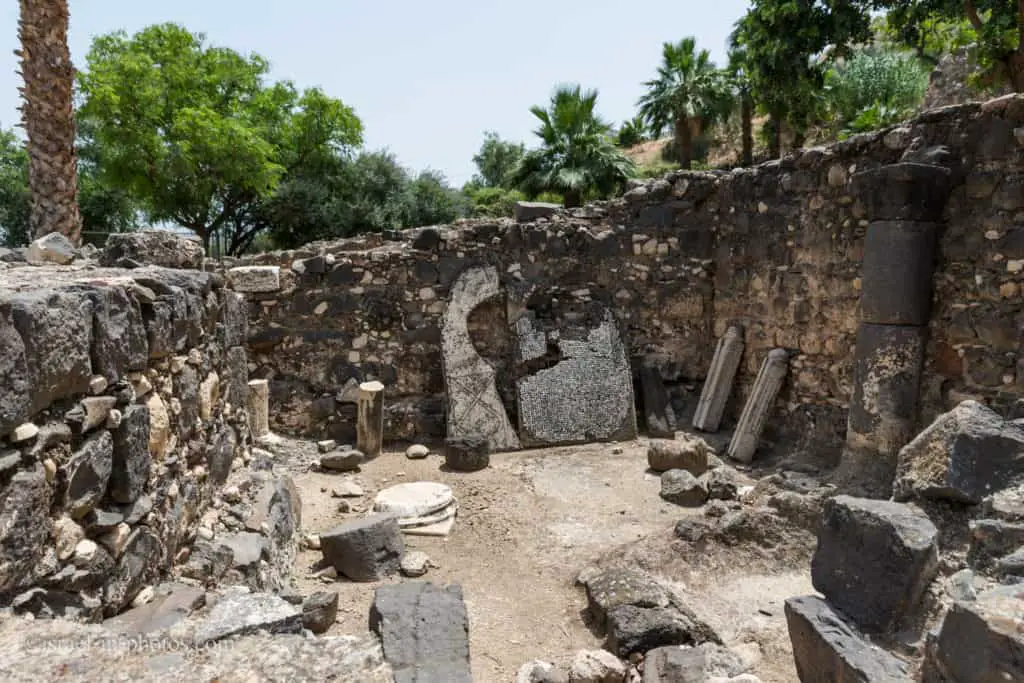
And now, let’s enter inside the building and see the Synagogue’s beautiful mosaics.

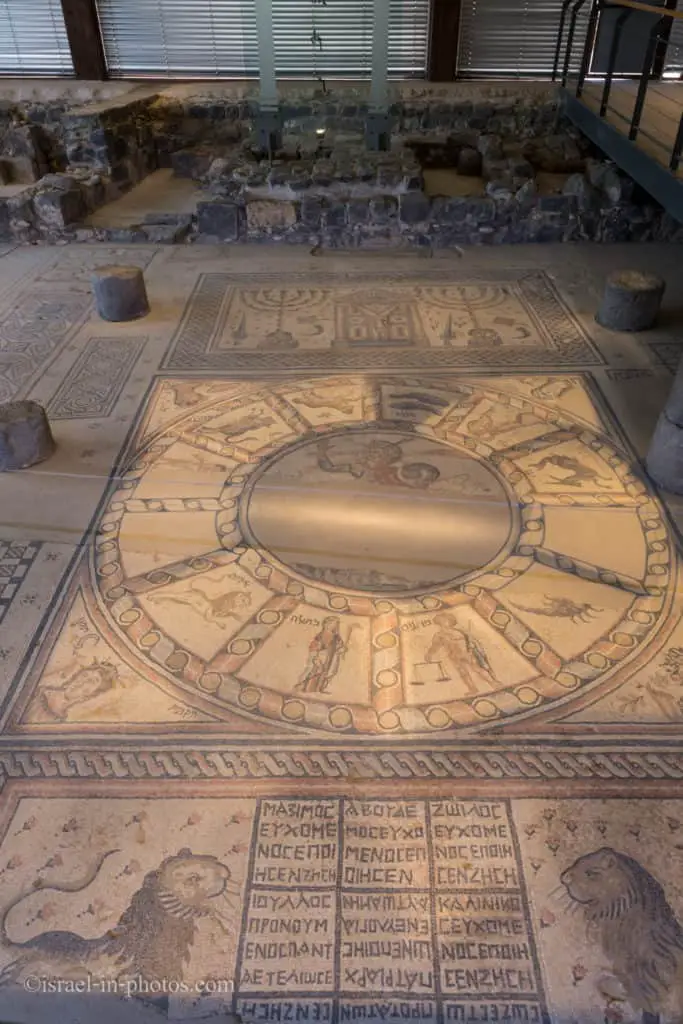
There were three stages of the Synagogue. Let’s go over them.
First century CE
This synagogue underwent three stages.
The first synagogue was built about 230 CE, on the remains of an earlier public building. From this synagogue, which was apparently destroyed in the 3rd century, only a small piece of mosaic remains displayed at the southern edge of the central mosaic, on a slightly lower level.

Third and fourth century CE
The second synagogue existed in the 3rd and 4th centuries CE and left behind a glorious mosaic floor, one of the earliest discovered in synagogues in Israel. The mosaic is divided into three panels. The northern section shows two lions, flanking nine inscriptions in Greek memorializing donors. In the middle – a spectacular Zodiac surrounding an image of Helios, the sun god. And in the southern section – the Ark of the Torah with Jewish symbols such as two seven-branched candelabras, a shofar, and a lulav.
At the four corners of the mosaic, there are images of four women symbolizing the four seasons of the year. Crops and pieces of clothing related to the seasons. One of the inscriptions mentions a person named Severus who grew up in the home of the “Illustrious Patriarchs”. Some call this synagogue after him – Severus’ Synagogue.
Showing the sun god in the middle of the mosaic and images of naked men in the Zodiac signs of Libra and Aquarius seems questionable. What have all these got to do with a synagogue? Similar images have also been found in other synagogues, such as the one in Bet Alfa. The multiplicity of Greek names mentioned in the inscriptions is also very prominent. All this might indicate that Judaism felt sufficiently secure and was not afraid that such expressions might threaten its status.
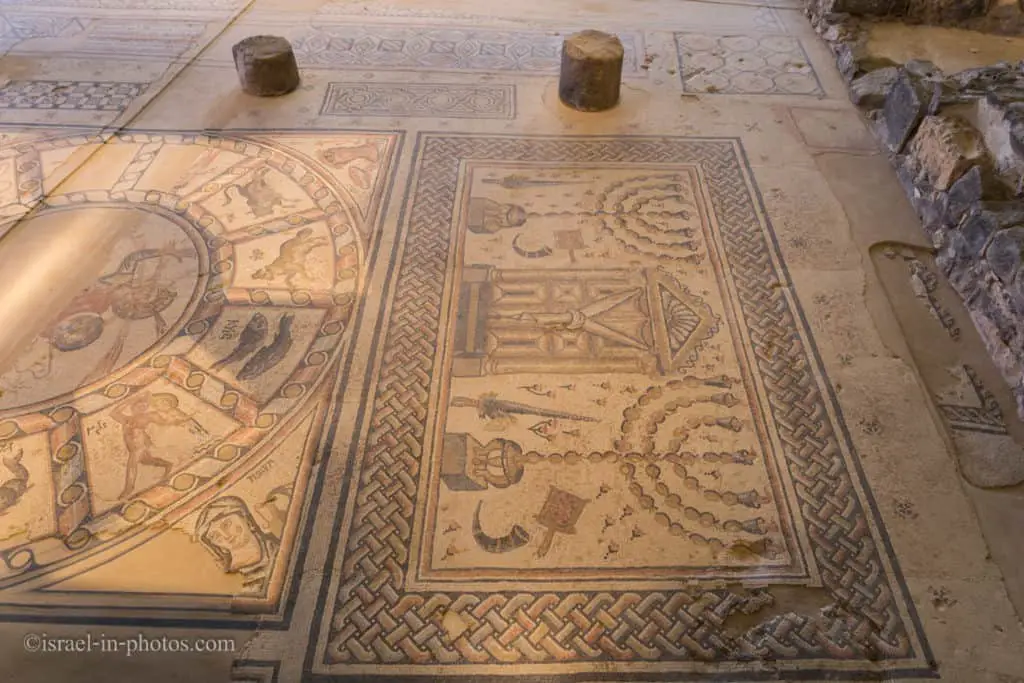
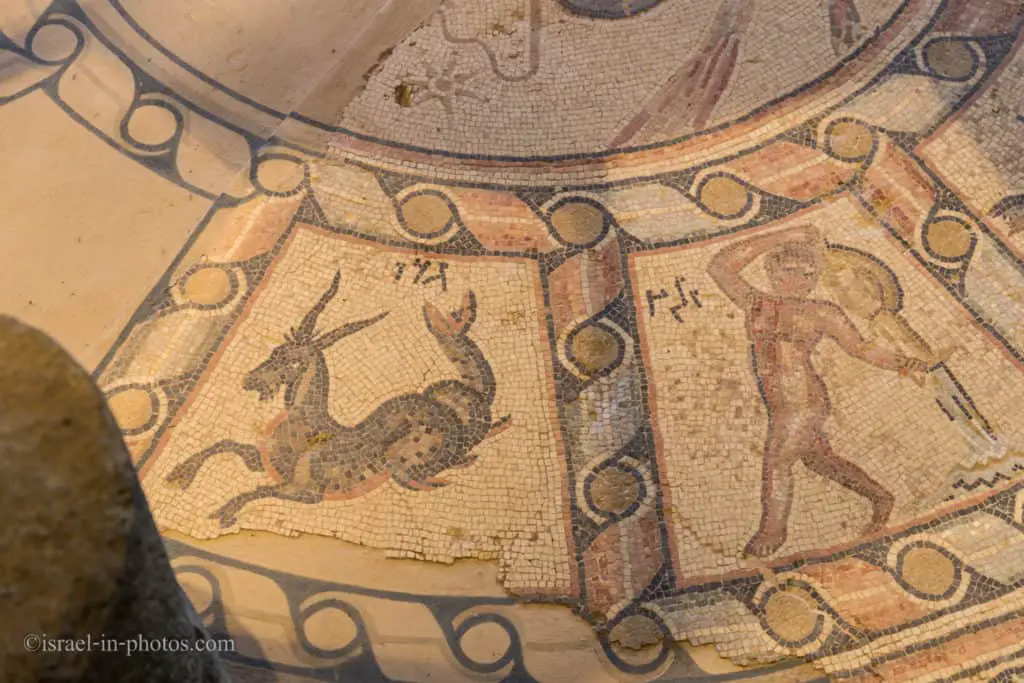
Fifth to eighth century CE
The Severus Synagogue appears to have been destroyed in an earthquake at the beginning of the 5th century. In its place, a larger structure was built containing a hall divided into three spaces by two rows of columns. At the southern end, beyond the shed, a semi-circular praying niche is displayed. This synagogue functioned up to the 11th century with slight changes.
Note: this stunning zodiac mosaic resembles the one in Beit Alfa Synagogue National Park.
Greek inscriptions:
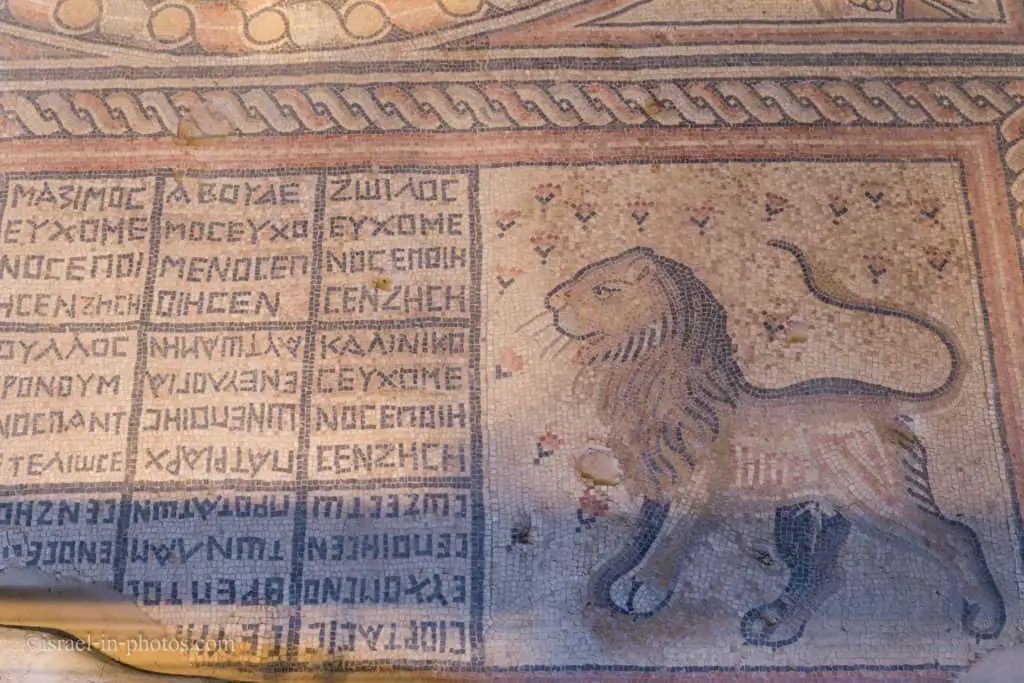
Courtyard of the later Synagogue:
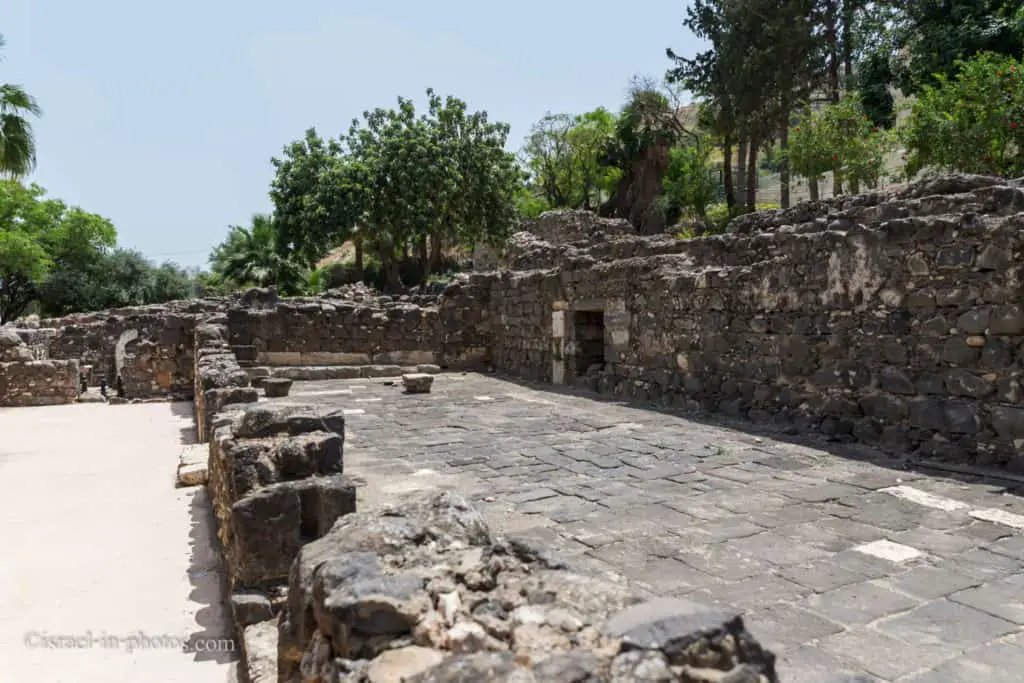
Roman Baths
The last section of Hamat Tiberias that we have not visited is the Roman baths. It is a small part of the park, and here is the relevant quote from the official site.
Remains of Ancient Baths – at the southern end of the site remains of baths from the Roman period were found. The area of the baths has not yet been explored, except for a plastered pool that served for bathing and stone arches that supported an upper structure that did not survive.
Summary
Hamat Tiberias National Park is not big, and a typical visit will take 1 – 1.5 hours. Thus you can combine it with Gamla, Korazim, Capernaum, Arbel, or any other point of interest in this area. You can find them all at the Sea of Galilee.
But as you saw, despite its size, there is plenty of history and things to see.
Have you ever been to Hamat Tiberias National Park? Tell us about your experience in the comments below.
That’s all for today, and I’ll see you in future travels!
Stay Tuned!
Additional Resources
Here are several resources that I created to help travelers:- Trip Planner with Attractions and Itineraries is the page that will help you create your perfect travel route.
- What is the Best Time to visit Israel? To answer this question, we will consider the weather, prices, holidays, festivals, and more.
- Information and Tips for Tourists to Israel will answer the most common questions tourists have about Israel (including safety, passports, weather, currency, tipping, electricity, and much more).
- Israel National Parks and Nature Reserves include a complete list, top ten, map, tickets (Israel Pass, Matmon, combo), and campsites.
- If you are looking for things to do, here are the pages for Jerusalem, Tel Aviv, Haifa, Sea Of Galilee, Akko (Acre), Eilat, Nazareth, Safed (Tzfat), and Makhtesh Ramon.


